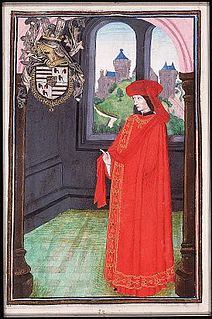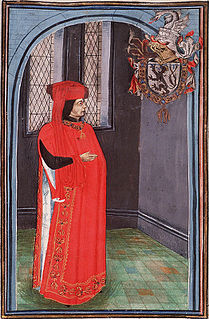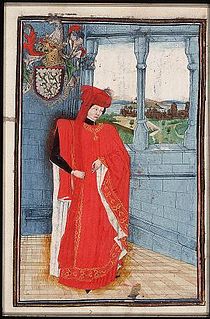 W
WJean de Créquy was born in 1395 into the military Créquy family, dating back to the 10th century, the son of Jean IV (1366–1411) and Jeanne de Roye (1375–1434).
 W
WAntoine I de Croÿ, Seigneur de Croÿ, Renty and Le Roeulx, Count of Porcéan, was a member of the House of Croÿ.
 W
WBaldwin van Lannoy, Lord of Molembais, nicknamed "Le Bègue" was a Flemish statesman, and ambassador for Philip the Good at the court of Henry V of England.
 W
WJean de Villiers, lord of L'Isle-Adam was a French nobleman and military commander who fought in the Hundred Years' War. As a supporter of the Duke of Burgundy, he fought on both sides of the conflict – English and French. He was a Marshal of France and a founding member of the knightly Order of the Golden Fleece.
 W
WLouis de Bruges, Lord of Gruuthuse, Prince of Steenhuijs, Earl of Winchester, was a Flemish courtier, bibliophile, soldier and nobleman. He was awarded the title of Earl of Winchester by King Edward IV of England in 1472, and was Stadtholder of Holland and Zeeland 1462–77.
 W
WJacques de Luxembourg, Seigneur de Richebourg was a French noble who served Charles the Bold, Duke of Burgundy and later King Louis XI of France.
 W
WJean II de Croÿ, was Count of Chimay and progenitor of the line of Croÿ-Solre. Jean belonged to the powerful House of Croÿ.
 W
WJean de la Trémoille, seigneur of Jonvelle, was Grand Master and Grand Chamberlain to the dukes of Burgundy John the Fearless and Philip the Good. He was the son of Guy and Marie de Sully, Princess of Boisbelle and Countess of Guînes. On 17 July 1424 he married Jacqueline d'Amboise, daughter of Ingerger II and Jeanne de Craon.
 W
WJohn II of Luxembourg, Count of Ligny was a French nobleman and soldier, a younger son of John of Luxembourg, Lord of Beauvoir, and Marguerite of Enghien. His older brother Peter received his mother's fiefs, including the County of Brienne, while John received Beaurevoir. He married Jeanne de Béthune, Viscountess of Meaux, widow of Robert of Bar, on 23 November 1418, and became step-father to Jeanne de Bar, Countess of Marle and Soissons. He and Jeanne de Béthune had no children.
 W
WSimon de Lalaing (1405–1476) was an Admiral of Flanders from 1436 to 1462, after which he relinquished the title to his eldest son Othon de Lalaing. He was made a knight of the Order of the Golden Fleece in 1431.
 W
WGuillebert de Lannoy, was a Flemish traveler and diplomat, chamberlain to the duke of Burgundy, governor of the fort of Sluys, and a knight of the Golden Fleece.
 W
WHugo van Lannoy, Lord of Santes, was a Flemish statesman in the service of the Dukes of Burgundy, most notably Philip III who founded the Order of the Golden Fleece.